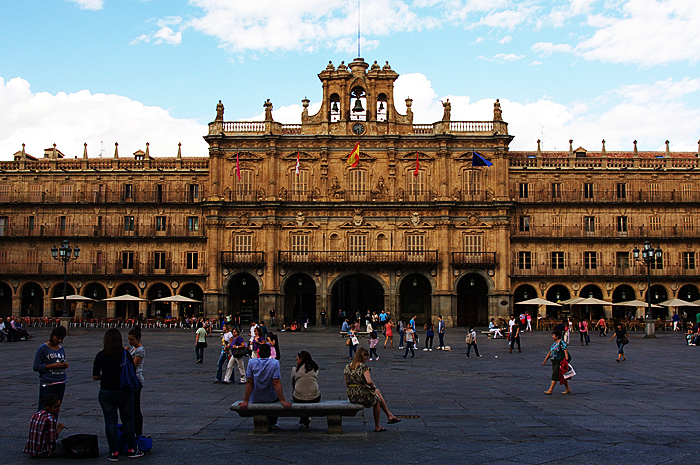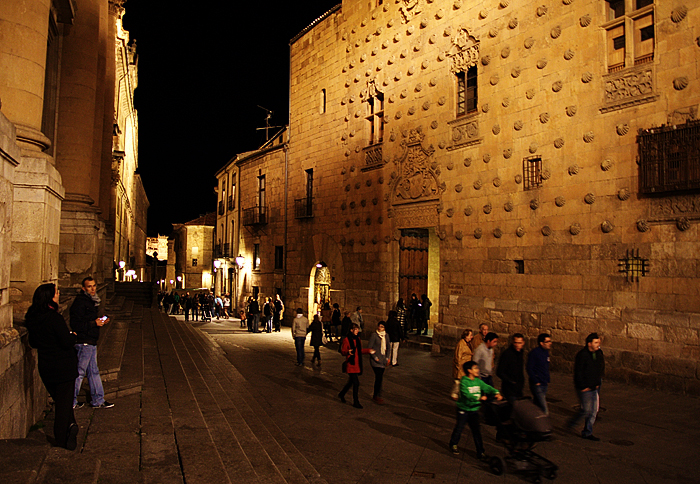by Marius Stankiewicz
While Madrid is often considered the heart of Spain – or perhaps the geographical middle of the Iberian Peninsula since you could literally stand in Puerta de Sol marking KM 0 of all outward bound roadways – Salamanca, on the other hand, may very well be the ‘golden milestone’, the crossroads of Spanish history where the Romans, Visigoths, and Moors had all left behind a rich legacy of architecture, cuisine, and of course; language.

In the main square, Plaza Mayor, I was to meet my guide, Marina; a Salmantina who spoke in a peculiar way causing me to be a bit more attentive to her castellano. My Spanish teachers, in fact, were all from Colombia or Argentina and had left me with the seseo and not the ceceo, the dialect also known as the Castilian lisp.
Marina showed me around the old town declared a UNESCO World Heritage Site in 1988. For all its sandstone colleges, churches and towers, which glow in a setting sun, I could see how it has long been known in Castille y León as La Ciudad Dorada, The Golden City.
As Marina was explaining the city’s best features, I realised how intrigued I was not only to see baroque antiquities but also to hear her make those delicate crease-like taps with her tongue. Her “Plaza Mayor” was extraordinary and unique-sounding even for my well-nigh perfect fluency in the language. It, in fact, sounded nothing like a speech defect and more like a sensually lisped and slightly rolled ‘pla-THA my-YOUR’.
Thus, my first lesson in the Castilian lisp was not only how well-preserved the language has been but also how unintentionally licentious its pronunciation could be, even of a word which recalls a history of gory bullfights though which nowadays reminds tourists of Europe’s most public living room. No wonder students from all over the world converge on Salamanca for Spanish lessons during the summer months: to learn a dialect which finds its equal in the Queen’s English, if not to exchange a lovers’ spit right outside of Cervantes’ erstwhile classroom.
One of the oldest universities in the world
Founded in 1218 by the reconquering Alfonso IX, the University of Salamanca is known not only for being one of the oldest universities in the world but also for having an architecture blending Baroque, Gothic and Renaissance motifs. Its façade is considered the most representative of the Plateresque and with all its details engraved with such meticulous splendour; one could see how it truly looks to be in the ‘manner of a silversmith,’ as what the style’s name suggests.
Before his explorations, Christopher Columbus commissioned the university’s professors to research the best route to the Indies and Antonio de Nebrija, a scholar in classical literature published in Salamanca the first ever Grammar book of a language which has graced the ears of more than 400 million people worldwide: Gramática de la Lengua Castellana. Was it a coincidence that the book’s publication was also the year Columbus left for the New World? Either way, for many locals like Marina, 1492 is still considered the annus mirabilis for the Spanish Empire, which most probably gave Queen Isabella of Castile a good enough reason to put a feather in her…crown.
At cultural crossroads
Despite Columbus erring his final destination, Spaniards back home always seem to find their bearings. Particularly in Salamanca as the city serendipitously sits at the junction to the popular Camino de la lengua castellana – a major cultural route showing the development of the Spanish language – and the Via de la Plata – a trail harking back to ancient Rome connecting the South of the peninsula to the North by commerce and spiritual peregrination.
Head 200 kilometres towards León and follow the scallop Shell markers westward and you will eventually merge onto another famous pilgrimage, the Camino del Santiago. Its route begins in St Jean Pied de Port in France, or Roncesvalles in Spain, and finishes where St. James’ remains were laid to rest, at the Cathedral of Santiago de Compostela.

After a day of exploring, I finally managed to ask Marina about that lisp, the adulterous dental fricative. But before receiving a reasonable answer I was, to my surprise, reprimanded: “Hombre!” Marina said, “the Castilian lisp, which you find so sexy, is our history!” And with an assortment of thespian hand gestures she then added, “it is like, por ejemplo, what the Plateresque is to Salamanca; flamenco to Andalucia; or what Gaudi is to Barcelona. But instead, this Castilian lisp is the language for the whole of Spain!”
Marius is a writer and photographer currently living in Barcelona. You can follow him at www.mariusstankiewicz.com. Read more about Marius’ encounter with Salamanca and the Castilian cuisine.
Learn more


